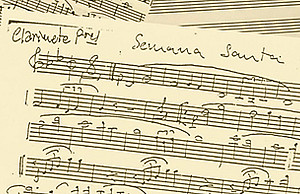Fundada como Mayordomía en 1939, desfiló por primera vez en el año 1940. Fue organizada por un grupo de ciezanos, preocupados y devotos del espíritu religioso de nuestras fiestas de Semana Santa, que pretendían incorporar a nuestros Desfiles un Paso hasta entonces ausente de ellos (Jesús, recién descendido de la cruz, a los pies de su dolorosa madre). El escultor murciano José Planes compuso para la Hermandad este Paso con la Imagen tallada de un Cristo Yacente y con otra de vestir de la Virgen por encargo de la Hermandad para la Semana Santa de 1940 (La Imagen de la Virgen sería sustituida en 2005 por la de Nuestra Señora del Mayor Dolor, Imagen también de vestir, obra del afamado escultor sevillano Luis Álvarez Duarte, a quien se la adquirió la Hermandad de Santa María Magdalena); el grupo fue instalado sobre un trono de madera dorada, realizado por Bautista Molina, que fue sustituido en 2005 por otro, encargado a tal fin por la Hermandad de Santa María Magdalena, tallado en madera en Sevilla, en los talleres de los Hermanos Ibáñez Valles, dorado por Manuel Carmona y con esculturas de Encarnación Hurtado que desfiló completamente acabado en la Semana Santa de 2007.
Quiso asimismo implantar la Hermandad, como complemento de la Liturgia Pasionaria, el Sermón de las Siete Palabras, que sólo tuvo vigencia durante breves años. Bajo el mandato de D. Antonio Pérez Gómez, el auténtico inspirador de esta Hermandad, su primera Camarera, Dña. Purificación Gómez, esposa de este, regaló el manto de terciopelo bordado en oro para la Imagen de la Virgen, y poco después el matrimonio costeó en la Basílica de Nuestra Señora de la Asunción la capilla en la que el Paso recibe culto. La cual fue restaurada en el año 2016 bajo la Presidencia de D. José María Navarro Pérez.
A lo largo de los años que distan de su fundación a hoy dos características se han mantenido incólumes: por un lado el desfile de mujeres ataviadas de riguroso luto con mantilla española y de hombres con traje negro, y por otro la pervivencia de la cera como alumbrado para ambos. Las túnicas de los Anderos, en sus orígenes negras, se tornaron azules desde el momento en que el Desfile Procesional del Paso fue asumido por la Hermandad de Santa María Magdalena (después de unos cuantos años en los que fue procesionado entre otras por la Cofradía de La Oración del Huerto y El Santo Sepulcro, por la Cofradía del Descendimiento de Cristo y Beso de Judas, y por la Cofradía de la Samaritana, por no contar con Cofrades propios).
Desde que la Hermandad del Santísimo Cristo Yacente quedara vinculada a la de Santa María Magdalena en la década de los ochenta por voluntad de los fundadores de aquélla, se han acometido varias obras de restauración: la de las Imágenes, realizada en 1992 por el ciezano Antonio Martínez Villa, y la de su antiguo Estandarte, llevada a cabo por los Talleres de Felicitación Gaviero en 2023. Finalmente la Hermandad recuperó para sus anderos en 1996 el tradicional 'gorro de verdugo' y en el año 2005, bajo la presidencia de D. Joaquín Gómez, modificó el diseño de este al incorporar un Tercio de nazarenos a su cortejo.
Fotografía de Manuel Carpio.
© Junta de Hermandades Pasionarias de Cieza















